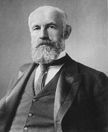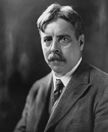

|
 |

December 15, 1999
The 1900s
Jane Addams | Ellwood P. Cubberley | John
Dewey | Cardinal Dennis Dougherty | Pierre Samuel Du Pont | W. E. B.
DuBois | Father Flanagan | Margaret Haley | G. Stanley Hall |William
Heard Kilpatrick | Clarence D. Kingsley |
Robert S. and Helen Merrell Lynd | Endicott Peabody | Walter M.
Pierce | John T. Scopes | Anne Sullivan | Edward L.
Thorndike | Booker T.Washington | William A. Wirt | Ella Flagg
Young
Ahead of Her Time:
Ella Flagg Young
|
When Ella
Flagg Young took office as the
elected superintendent of
the Chicago schools in 1909, she confidently declared that
"in the near future, we

|
|
Chicago Historial Society
|
will have more women than men in executive charge of the vast
educational system." But,
in fact, for more than 60 years Young remained almost alone in
her achievement, one of a
very few women with enough political clout and experience to land
the top job in a large
district. Just as extraordinary, both as Chicago superintendent
and as president of the
National Education Association-the first woman to hold either
post- Young promoted an
ideal of teacher power and school democracy radically at odds
with the views of many of
her prominent colleagues.
Born in 1845, Young attended school for only a few years,
though her working-class
parents encouraged her independence of mind and spirit. At 17,
after attending normal
school, she took her first teaching job. Her pupils were the
young men who herded cattle
on the outskirts of Chicago. She married at 23, but became a
widow soon after. Young
eventually rose to become principal of the system's largest high
school before being named
assistant superintendent in 1887.
At the age of 50, she took a seminar with the philosopher and
educator John Dewey, who
was then teaching at the University of Chicago. The two began a
rich collaboration, with
Young using her own experience to test Dewey's ideas. After
resigning from the school
system in 1899 because she disagreed with the autocratic approach
of the new
superintendent, Young earned her doctorate under Dewey.
In 1905, she became the director of the Cook County Normal
School, continuing her close
association with teachers. Teachers and suffragists, using the
vote women won for Illinois
school elections in 1891, helped Young win the race for
superintendent, and in 1910 she
also became president of the male-dominated NEA.
Her tenure as superintendent was marked not only by reforms
but also by battles with
school board members. After seven turbulent years on the job,
Young retired, remaining
active in education and politics until her death in 1918.
óBess Keller |
John Dewey

|
|
Teachers College, Columbia
University
|
Called the "most
influential writer on education" and the "greatest philosopher" the
United States has produced, his name is synonymous with the rise of
progressive education. In The School and Society (1899), he sought to
define the relationship between education and the development of an
active, informed citizenry. Many more books would follow, and his
immense body of writing is still studied-and fiercely debated.
Margaret Haley
As a Chicago union organizer,
she battled a factory model of schooling that she feared would turn
teachers into assembly-line workers. In 1901, as the first woman to
speak from the floor of a National Education Association convention,
Haley declared that teachers were grossly underpaid and overworked.
Nea President William T. Harris discounted her views as the ravings
of a "worn-out, tired, and hysterical" grade school teacher.

Clark University
|
G. Stanley Hall
In two books,
Adolescence (1904) and
Educational Problems (1911), he popularized the notion of
adolescents as a distinct group and laid out implications of their
development in education.
Booker T. Washington
Through hard work,
industry, and practical skills, Washington believed, African-
Americans would lift themselves out of poverty and into the middle
class. The program of occupational training, paid work, and academics
he launched at Tuskegee Institute in Alabama in the late 1800s and
early 1900s enabled more than half the students to pay their expenses
while remaining in school.
W. E. B. DuBois
While Washington stressed occupational training, DuBois
believed a highly educated "Talented Tenth" would lead black
Americans to full participation in society.
"The Negro race, like all
races, is going to be saved by its exceptional men," he argued in a
1903 essay. DuBois advanced the pursuit of higher education and
broader intellectual skills among African-Americans.
Endicott Peabody
The founding rector of
Groton, who during his 56-year tenure turned the Massachusetts
institution into one of the country's premier private residential
high schools. His vision of a total educational environment in which
boys and their teachers lived and learned together-while focused on
the goal of moral development-helped set the tone of the modern
boarding school movement.
Jane Addams
In the 1890s and early 1900s, Chicago's Hull House became the
most famous of the "settlement houses" for immigrant families, and
its founder an international advocate for women, children, and the
working poor. Addams' expansive view of their educational and social
needs was reflected in Hull House's free kindergarten and day
nursery, playground and health services, art exhibitions, college-
extension courses, summer school, and classes in cooking and sewing.
"A settlement soon discovers that simple people are interested in
large and vital subjects," she wrote in her 1910 book, Twenty
Years
at Hull-House.
Edward L.
Thorndike

|
|
Teachers College, Columbia
University
|
He pioneered many of the first standardized
achievement tests in specific subjects and worked with Lewis M.
Terman and others to devise the hugely influential Army intelligence
tests used during World War I and after. The Teachers College
scholar, in a departure from Dewey, developed a style of education
research rooted in universities, not schools.
Ellwood P.
Cubberley
A founding father of school administration as a
profession distinct from teaching and one imbued with a faith in
scientific management. As a professor and dean at Stanford University
from 1898 to 1933, he trained two generations of administrators and
put his stamp on the way schools were run nationwide.
Cardinal Dennis Dougherty
Archbishop of
Philadelphia from 1918 to 1951, who as "God's Bricklayer" exemplified
the heyday of the Roman Catholic commitment to a separate school
system. Under his prodding, the number of parochial grade schools in
the archdiocese jumped from 174 to 305, and nine diocesan and 22
parish high schools opened.
Walter M. Pierce
Democrat elected governor of Oregon in 1922 on a platform
that included support for a Ku Klux Klan-backed ballot measure
requiring children to attend public schools. The measure passed but
backfired. The result has been called the Magna Carta of private
education: the 1925 U.S. Supreme Court decision in Pierce v. Society
of Sisters, affirming the right to private schooling.
Father Flanagan

|
|
Boys Town
|
Edward Joseph Flanagan
founded Boys Town, a Nebraska refuge dedicated to the education and
training of delinquent and homeless boys, in 1917 with a $90 loan.
Under the Catholic priest's direction, Boys Town grew into a
community with its own boy-mayor, schools, chapel, post office,
cottages, gymnasium, and other facilities. Made famous by the 1938
movie starring Spencer Tracy, the town continues today-now with
satellite campuses around the country. It began admitting girls in
1979.
Clarence D.
Kingsley
This Massachusetts educator chaired a National
Education Association panel whose 1918 report shaped secondary
education for decades to come. Marking a shift from academic to
nonacademic goals in schooling, it laid out seven basic teaching
objectives: health, command of fundamental processes, worthy home-
membership, vocation, citizenship, worthy use of leisure, and ethical
character.
William A. Wirt
Creator of the "Gary Plan," named for the Indiana district he
served as superintendent from 1907 to 1938. Marked by its "platoon
system" for shepherding youngsters through a daily regimen of work,
study, and play, the plan was in at least partial use in some 200
districts by the late 1920s.
William Heard
Kilpatrick

|
|
Teachers College
|
One of the most popular teachers in the
history of Teachers College, Kilpatrick was a self-described
"interpreter" of Dewey. In a widely read 1918 article, Kilpatrick
urged schools to abandon passive instruction and engage children in
"wholehearted purposeful activity" in a social environment-an
approach he called the "Project Method."
Pierre Samuel
Du Pont
American industrialist and a leader in the first
big era of business involvement in education. Beginning in 1918, he
worked to improve Delaware's schools through philanthropy, public
awareness, and legislative action. For years, he personally financed
virtually the entire school system for blacks in that segregated
state.
Robert S. and Helen
Merrell Lynd
Husband-and-wife sociology team who peeled
back the skin of Muncie, Ind., and laid bare its anatomy in their
1929 book, Middletown. The pioneering work also offered a window into
attitudes about education, as the Lynds described a community that
took great pride in its schools, but cared little about the life of
the mind.
John T. Scopes
Twenty-four-year-old Tennessee science teacher at the center
of the celebrated 1925 "Monkey Trial," which riveted national
attention on issues of academic freedom, evolution, and deeply held
religious beliefs-conflicts that continue today.
Anne Sullivan

|
|
Helen Keller International,
Inc.
|
The remarkable story of
this nearly blind teacher and her pupil, Helen Keller, showed the
world that even a profoundly "handicapped" child could learn.
Keller's 1903 autobiography told how, beginning in 1887, the 20-year-
old Sullivan taught the blind and deaf 6-year-old to communicate
using an alphabet based on signals pressed into the palm of her hand.
Keller and her teacher traveled the world, speaking out for people
with disabilities. "The Miracle Worker," a 1959 play, dramatized
Sullivan's success with her young student.
© 1999 Editorial Projects in Education  Vol. 19, number 16, page 28-29 Vol. 19, number 16, page 28-29
|








